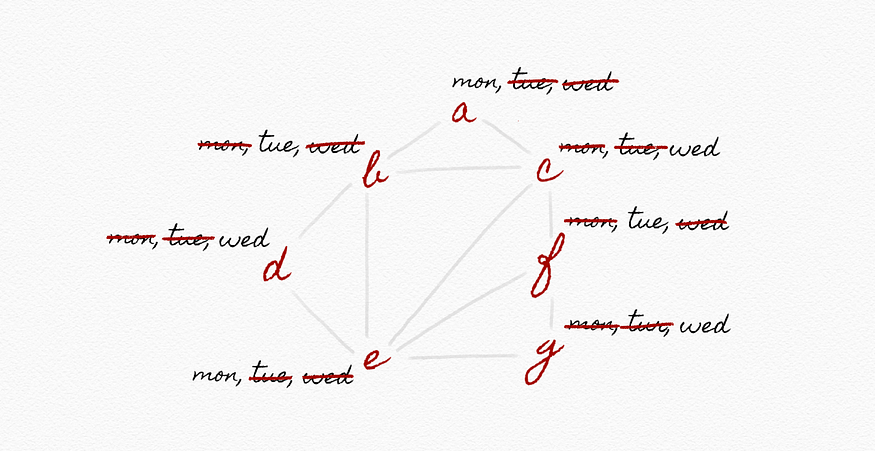
28 Words About Optimization, Every AI-Savvy Leader Must Know
Last Updated on July 20, 2023 by Editorial Team
Author(s): Yannique Hecht
Originally published on Towards AI.
Artificial Intelligence
Think you can explain these? Put your knowledge to the test!

[This is the 4th part of a series. Make sure you read about Search, Knowledge, and Uncertainty before continuing. The next topics are Machine Learning, Neural Networks, and Language.]

Over two-thirds of artificial intelligence’s value creation comes from improving existing systems and processes. This is according to McKinsey’s ‘Notes from the AI frontier’ (a highly-recommended resource and strategic business perspective on AI value creation).
Although this statistic includes both traditional and advanced techniques and a wide range of AI applications, its major share is rooted in simple optimization problems. Think, revamping logistics of global supply chains or raising the accuracy of financial prediction models.
AI can create $15.4 trillion in value, each year.
In Optimization, the objective is to choose the best possible from a set of predetermined options, often hidden deep in the data. To unlock incremental value, we can leverage methods like local search, linear programming, or constraint satisfaction to create practical, real-world applications.
To get you going in this exciting field, this article briefly defines the main concepts and terms.
Optimization
local search: search algorithms that maintain a single node and searches by moving to a neighboring node
state-space landscape: a process, in which successive states of an instance are considered, with the objective of finding a goal state with the desired property
global maximum: the largest overall value of a set, function, etc., over its entire range

global minimum: the smallest overall value of a set, function, etc., over its entire range

objective function: the function that it is to maximize (e.g., for revenues)
cost function: the function that it is to minimize (e.g., for costs); it could look like this:
50[x1] + 80[x2]
current state: (or configuration) the dynamic set of currently stored inputs, variables, and constants in memory

hill-climbing: an optimization technique that is used to find a “local optimum” solution to a computational problem; variants include steepest-ascent, stochastic, first-choice, random-restart, and local beam search

steepest-ascent: hill-climbing variant, which chooses the highest-valued neighbor
stochastic: hill-climbing variant, which chooses randomly from higher-valued neighbors
first-choice: hill-climbing variant, which chooses the first higher-valued neighbor
random-restart: hill-climbing variant, which conducts hill-climbing multiple times
local beam search: hill-climbing variant, which chooses the k highest-valued neighbors
simulated annealing: a technique used to optimize complex search algorithms
linear programming: a mathematical method to determine the best possible outcome from a defined of options or requirements, represented as linear relationships
simplex: a common linear programming algorithm
interior-point: another common linear programming algorithm
constraint satisfaction: the process of finding a solution to a set of constraints that impose conditions that the variables must satisfy; types of constraints include hard, soft, unary, and binary

constraint function: a function specifying the prescribed conditions in a nonlinear programming problem, (i.e., time, labor, or input); it could look like this:
5[x1] + 2[x2] <= 100
hard constraints: constraints that must be satisfied in a correct solution
soft constraints: constraints that express some notion of which solutions are preferred over others
unary constraint: constraint involving only one variable
{A ≠ Monday}
binary constraint: constraint involving two variables
{A ≠ B}
node consistency: when all the values in a variable’s domain satisfy the variable’s unary constraints
arc consistency: when all the values in a variable’s domain satisfy the variable’s binary constraints; to make A arc-consistent with respect to B, remove elements from A’s domain until every choice for A has a possible choice for B
A {mon,tue, wed}
B {mon, tue, wed}
...

back-training search: a depth-first search algorithm that systematically assigns all possible combinations of values to the variables to check if these assignments constitute a solution
maintaining arc-consistency: an algorithm for enforcing arc-consistency every time we make a new assignment
least-constraining values heuristic: method to return variables in order by number of choices that are ruled out for neighboring variables (try least-constraining values first)
Now that you’re able to explain essential Optimization related terms, you’re hopefully more comfortable exploring this broad field further on your own.
However, you cannot complete your journey to becoming a fully-fledged AI-savvy leader without exploring other related topics, including Search, Knowledge, Uncertainty, Learning, Neural Networks, and Language.

Like What You Read? Eager to Learn More?
Follow me on Medium or LinkedIn.
About the author:
Yannique Hecht works in the fields of combining strategy, customer insights, data, and innovation. While his career has been in the aviation, travel, finance, and technology industry, he is passionate about management. Yannique specializes in developing strategies for commercializing AI & machine learning products.
Published by Towards AI
Join thousands of data leaders on the AI newsletter. Join over 80,000 subscribers and keep up to date with the latest developments in AI. From research to projects and ideas. If you are building an AI startup, an AI-related product, or a service, we invite you to consider becoming a sponsor.
Published via Towards AI
Take our 90+ lesson From Beginner to Advanced LLM Developer Certification: From choosing a project to deploying a working product this is the most comprehensive and practical LLM course out there!
Towards AI has published Building LLMs for Production—our 470+ page guide to mastering LLMs with practical projects and expert insights!

Discover Your Dream AI Career at Towards AI Jobs
Towards AI has built a jobs board tailored specifically to Machine Learning and Data Science Jobs and Skills. Our software searches for live AI jobs each hour, labels and categorises them and makes them easily searchable. Explore over 40,000 live jobs today with Towards AI Jobs!
Note: Content contains the views of the contributing authors and not Towards AI.
















